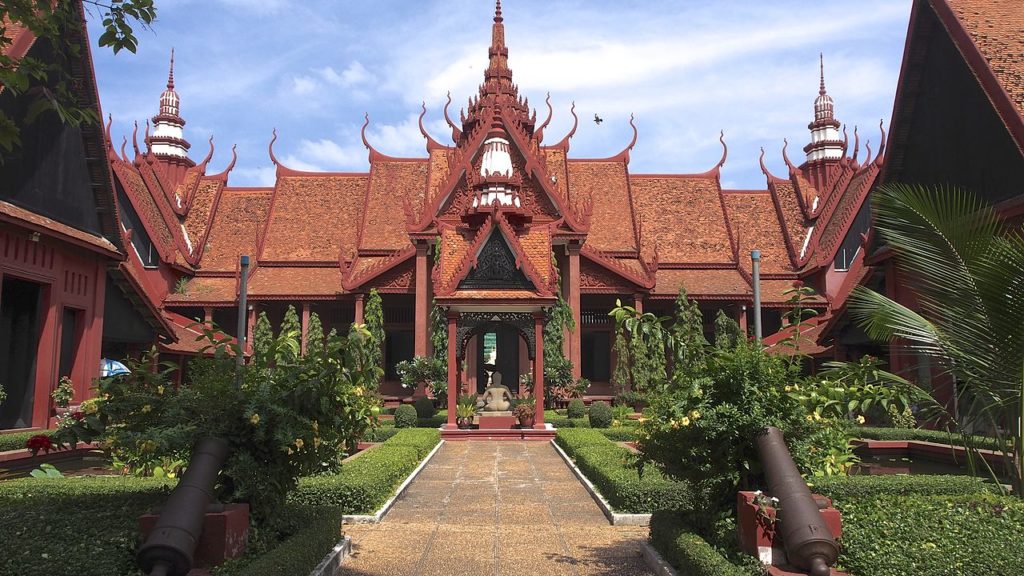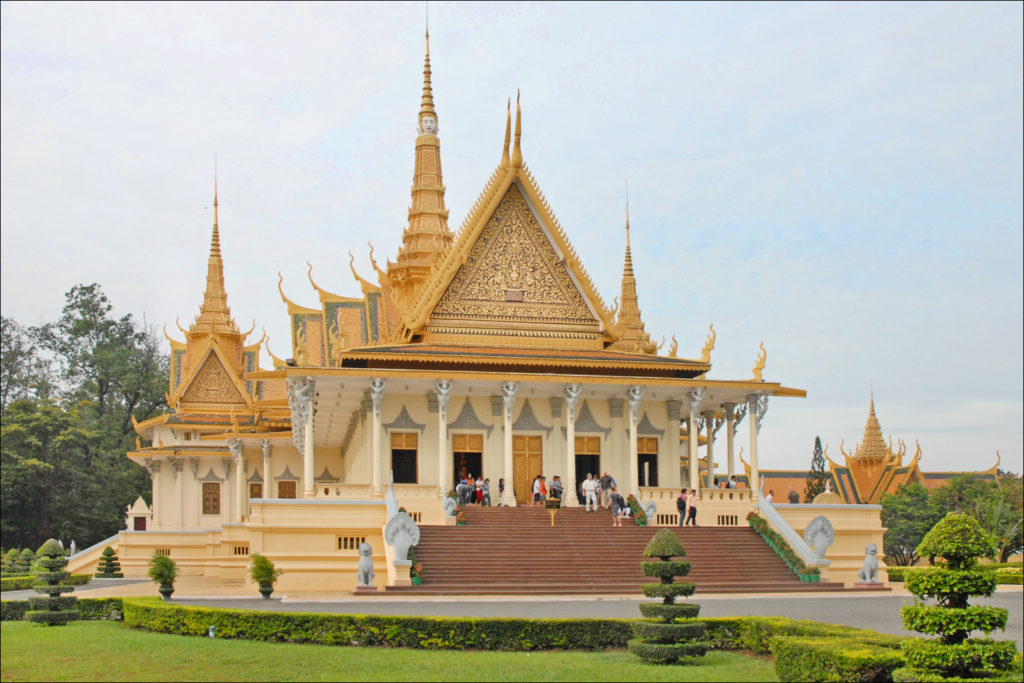The city got its name from a riverfront temple, Wat Phnom, and Lady Penh, a legendary noblewoman who established the temple back in 1372 – more than 50 years before Phnom Penh was chosen to succeed Angkor Thom as capital.
The settlement, however, is believed to date as far back as the 5th century. It was also previously known as Krong Chaktomuk or the “City of Four Faces”, owing to its location at the confluence of three rivers – the Tonle Sap, the Bassac and the Mekong, Southeast Asia’s longest river.
Today, Cambodia’s capital is a bustling cosmopolitan city with plenty to see and do for both urban explorers and nostalgia seekers, one that deserves a spot in your travel list.
Visit an ancient temple
Wat Phnom, one of the city’s oldest and most important Buddhist landmarks, sits atop a 27-metre high man-made hillock overlooking the Tonle Sap river.
Dotting the leafy compounds are a main temple guarded by two naga statues, pagodas, statues, spirit houses, as well as a stupa housing the remains of King Ponhea Yat, the last king of the ancient Khmer Empire.
 Sitting at the heart of the main temple is a stately bronze Buddha statue, while the walls and ceiling are beautifully adorned with hand-painted murals depicting scenes from the Reamker, the Khmer version of the ancient Indian epic Ramayana.
Sitting at the heart of the main temple is a stately bronze Buddha statue, while the walls and ceiling are beautifully adorned with hand-painted murals depicting scenes from the Reamker, the Khmer version of the ancient Indian epic Ramayana.
The site traces its roots back to 1372, while the main temple was rebuilt four times over six centuries, most recently in 1926.
Spend a day at the museum
Featuring traditional Khmer architecture inspired by the ancient temples of Angkor Wat, the National Museum of Cambodia is an imposing beauty with its terracotta wash and neatly manicured gardens with lotus pools.
It also boasts the world’s largest repository of Khmer artifacts and artworks. Regular visitors, however, will only get to see some 2,000 items displayed inside six galleries within the 5,190-square metre space.
 Not that you’ll ever get bored. The exhibitions here will bring you through the vastly rich story of Cambodia from the prehistoric era to the glory days of the Khmer Empire and its eventual decline, as well as various rare Buddhist and Hindu sculptures.
Not that you’ll ever get bored. The exhibitions here will bring you through the vastly rich story of Cambodia from the prehistoric era to the glory days of the Khmer Empire and its eventual decline, as well as various rare Buddhist and Hindu sculptures.
The museum, which first welcomed visitors in 1924, was designed by George Groslier, a Phnom Penh-born French architect, writer and historian.
Explore palatial splendours
The history of the Khmer kingdom may have spanned over a millenia, but the Royal Palace of Cambodia is relatively new, built in stages from 1866 to 1919 by King Norodom.
Some of the palatial gems to check out here are the throne hall, where important events like coronations, weddings, as well as government and diplomatic audiences are held, while royal sermons and classical dance performances typically take place at the Chan Chhaya Pavilion.

Other noteworthy attractions include the Silver Pagoda, a replica of Angkor Wat, a statue of King Norodom and an iron pavilion gifted by France’s King Napoleon III in 1876.
The current royal family still resides at Khemarin Palace, which is located on the western side of the 17.5-hectare palace grounds and is off limits to the public.
Learn all about Cambodian silk
For a change of pace, consider a visit to the Silk Island Traditional Weaving Village, located on the serene, quaint islet of Koh Oknha Tei on the Mekong.
Here, you’ll get to learn the art of Cambodian silk amid the rhythmic clanking of wooden looms that slowly but steadily transform silk threads into beautiful cloth.
What sets Cambodian silk apart are the golden silkworms that only thrive in hot, dry weather and feed on native mulberry leaves, creating yellow threads instead of the usual white.
This Khmer cultural heritage has existed since ancient times and is even depicted in bas-reliefs at Angkor Wat. Traditionally, the craft is passed down through mothers and daughters, with each household having their own loom.
Reflect on its dark history
The years between 1975 and 1979 were a dark period for Cambodia, when the Khmer Rouge, led by Pol Pot, wrested control of the country and unleashed genocide.
The 1.5 to 2 million deaths during this time can be attributed to famine and the brutal executions by the Santebal, the regime’s secret police that operated more than 150 detention camps.
The most infamous of these camps was Security Prison 21 (S21), now known as the Tuol Sleng Genocide Museum. The harrowing display of tiny cells, discarded shackles and torture devices, as well as prisoner mugshots and skulls inside the blood-stained halls of this former school make it one of Southeast Asia’s most haunting spots.
The horrors continue 17 kilometres southwest at the Killing Fields of Choeung Ek, where thousands of bodies were buried in 129 unmarked communal graves. Some trees were even used as both a killing tool and to mount loudspeakers in order to drown out the cries.
To honour the victims, a stupa and a monument housing more than 5,000 skulls were built at this spot in 1988. A prayer ceremony is also held annually on 20 May, Cambodia’s National Day of Remembrance.
According to airasia.com














